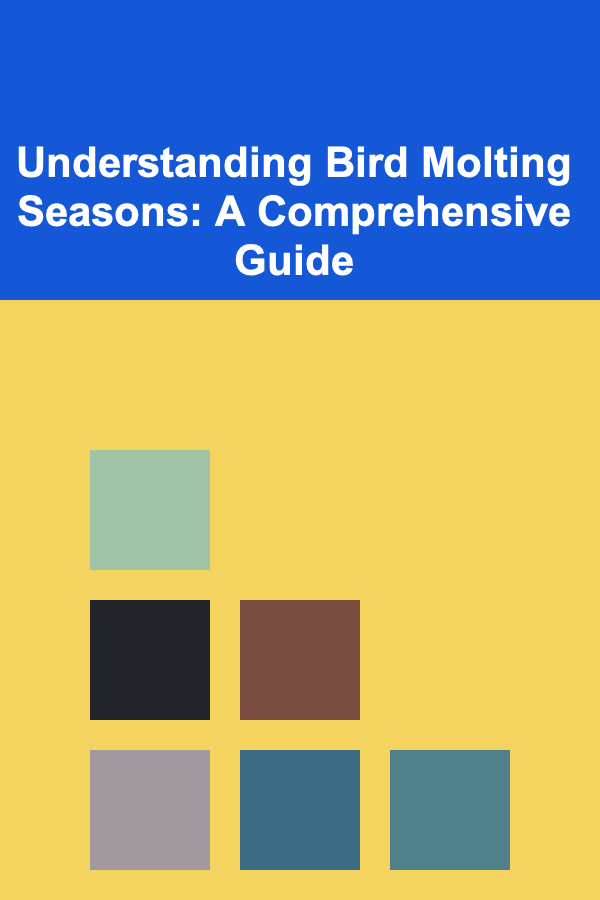
Understanding Bird Molting Seasons: A Comprehensive Guide
ebook include PDF & Audio bundle (Micro Guide)
$12.99$10.99
Limited Time Offer! Order within the next:

The annual cycle of a bird's life is a complex interplay of energy expenditure and behavioral adaptation. Reproduction, migration, and survival are all intrinsically linked. Central to this cycle is molting, the process by which birds replace their feathers. Far from being a simple shedding of old plumage, molting is a resource-intensive and carefully orchestrated event critical for maintaining flight capability, insulation, waterproofing, and visual signaling. Understanding the intricacies of bird molting seasons provides invaluable insight into avian biology, ecology, and conservation.
The Importance of Feathers and the Necessity of Molting
Feathers are far more than mere adornments; they are essential for a bird's survival. They perform several crucial functions:
- Flight: Flight feathers (remiges on the wings and retrices on the tail) are specifically designed to generate lift and control movement in the air. Their precise structure and arrangement are critical for aerodynamic efficiency.
- Insulation: Down feathers, with their fluffy structure, trap air close to the bird's body, providing essential insulation against cold temperatures. This is vital for maintaining a stable body temperature, particularly in colder climates.
- Waterproofing: Contour feathers, which cover the body, are coated with preen oil, secreted by the uropygial gland (located near the base of the tail). This oil creates a water-repellent barrier, preventing the feathers from becoming waterlogged and reducing heat loss.
- Camouflage and Signaling: Feather coloration and patterns play a significant role in camouflage, allowing birds to blend into their surroundings and avoid predators. Brightly colored feathers are also used for visual signaling, attracting mates, and establishing dominance hierarchies.
- Protection: Feathers act as a physical barrier, protecting the bird's skin from abrasion, sunlight, and insect bites.
Over time, feathers become worn, damaged, and infested with parasites. Exposure to sunlight fades their color, flight feathers fray and lose their aerodynamic integrity, and the waterproofing properties of contour feathers diminish. These factors reduce the bird's ability to fly efficiently, maintain body temperature, evade predators, and attract mates. Molting is the solution to this degradation, allowing birds to replace old, worn feathers with fresh, functional ones.
The Molting Process: A Detailed Look
Molting is not a random shedding of feathers; it's a carefully regulated physiological process. The process is controlled by a complex interplay of hormones, including thyroid hormones and sex hormones, and is highly sensitive to environmental cues such as photoperiod (day length) and food availability.
- Feather Growth: New feathers grow from feather follicles in the skin. Each feather develops within a sheath, a protective covering that eventually breaks open, releasing the fully formed feather. During the growth phase, the developing feather, known as a "blood feather," is supplied with blood via a central pulp cavity. This makes them particularly sensitive and susceptible to damage.
- Feather Loss: As the new feather develops, the old feather is gradually pushed out of the follicle. The shedding of feathers is typically symmetrical, ensuring that the bird maintains balance and flight capability. The exact sequence of feather loss varies depending on the species and molting strategy.
- Simultaneous vs. Sequential Molt: Some birds, like ducks and geese, undergo a simultaneous molt , losing all their flight feathers at once. This renders them flightless for a period of time, making them vulnerable to predators. These birds typically molt in safe, secluded areas with abundant food resources. Other birds undergo a sequential molt, replacing their flight feathers one or a few at a time. This allows them to maintain flight capability throughout the molting process, but it takes longer and requires a more sustained energy investment.
- Nutritional Demands: Molting is an energetically expensive process. Feathers are composed primarily of keratin, a protein that requires significant resources to produce. Birds undergoing molt require a diet rich in protein, vitamins, and minerals to support feather growth. They often increase their foraging efforts during the molting season.
Types of Molt and Molting Strategies
Birds exhibit a variety of molting strategies, each tailored to their specific ecological niche and life history. The type and frequency of molt can vary significantly between species, and even within a single species, depending on age, sex, and geographic location.
Based on Scope:
- Complete Molt: A complete molt involves the replacement of all the bird's feathers, including both flight feathers and body feathers. This is the most common type of molt and is typically associated with the end of the breeding season.
- Partial Molt: A partial molt involves the replacement of only some of the bird's feathers, typically the body feathers. This type of molt is often used to acquire breeding plumage or to replace feathers that have been damaged.
Based on Frequency:
- Post-juvenile Molt: The first molt a young bird undergoes after fledging. It replaces the juvenile plumage with a more adult-like plumage. The extent of this molt varies greatly between species.
- Pre-basic Molt (Annual Molt): The most common type of molt, occurring once a year after the breeding season. This results in the basic plumage, which is typically less colorful than the breeding plumage. This is often a complete molt.
- Pre-alternate Molt (Pre-breeding Molt): Some birds undergo a partial molt before the breeding season to acquire a more colorful or elaborate breeding plumage (alternate plumage).
- Supplemental Molt: Less common, this involves a small number of feathers being replaced outside of the regular molting seasons. This may be triggered by feather damage or wear.
Examples of Molting Strategies:
- Passerines (Songbirds): Most passerines undergo a complete post-breeding molt and a partial pre-breeding molt. The post-breeding molt replaces all their feathers, while the pre-breeding molt involves the replacement of a smaller number of feathers, typically on the head and throat, to produce a brighter breeding plumage.
- Waterfowl (Ducks, Geese, Swans): Waterfowl typically undergo a complete post-breeding molt, during which they lose all their flight feathers simultaneously and become flightless. This molt usually occurs in secluded areas with abundant food resources.
- Raptors (Hawks, Eagles, Owls): Raptors typically undergo a gradual molt, replacing their flight feathers one or a few at a time over a period of several years. This allows them to maintain their hunting abilities throughout the molting process.
- Hummingbirds: Hummingbirds undertake a gradual molt, often lasting several months, and replacing feathers sequentially to minimize any impact on their remarkable flight capabilities.
Factors Influencing Molting Seasons
The timing and duration of molting seasons are influenced by a variety of factors, including:
- Photoperiod (Day Length): Photoperiod is a primary cue for regulating the timing of molting. Changes in day length trigger hormonal changes that initiate the molting process.
- Food Availability: Molting is an energetically demanding process, so birds need access to abundant food resources to support feather growth. The timing of molting is often synchronized with periods of peak food availability.
- Breeding Season: Molting typically occurs after the breeding season, when birds have finished raising their young. This allows them to focus their energy on feather replacement without the demands of reproduction.
- Migration: Many migratory birds molt either before or after migration. Molting before migration ensures that they have fresh, functional feathers for the long journey. Molting after migration allows them to replenish their feathers after the stresses of travel. However, there are some migrants who undertake a 'suspended' molt, interrupting the process to migrate and then completing it in their wintering grounds.
- Age and Sex: Young birds often have different molting patterns than adults. Males and females may also have different molting patterns, particularly if they have different breeding plumages.
- Stress and Health: Stressed or unhealthy birds may experience delayed or incomplete molts. Parasite infestations and disease can also interfere with the molting process.
- Climate: Birds in colder climates may have a shorter molting season than birds in warmer climates, due to the need to prepare for winter.
Observing and Identifying Molting Birds
Recognizing molting birds can be a rewarding experience for birdwatchers. Here are some key characteristics to look for:
- Ragged Appearance: Molting birds often have a ragged or unkempt appearance due to the presence of pin feathers (feathers still in their sheaths) and gaps in their plumage where feathers have been lost.
- Patchy Plumage: Molting can create a patchy appearance, with areas of old, faded feathers interspersed with areas of new, brightly colored feathers.
- Dull Coloration: Some birds may appear duller in color during molt, as they are replacing their breeding plumage with their basic plumage.
- Behavioral Changes: Molting birds may be less active and more secretive than usual, as they are conserving energy and avoiding predators. They may also spend more time preening to remove the sheaths from their new feathers.
- Presence of Pin Feathers: Pin feathers are easily identifiable by their spiky appearance and the presence of a sheath at the base. Look closely, and you may even see a blood feather with a dark shaft, indicating it's still actively growing.
By observing these characteristics, you can gain a better understanding of the molting process and the life cycle of birds.
The Ecological Significance of Molting
Molting plays a critical role in maintaining the health and viability of bird populations. It affects not only individual birds but also the wider ecosystem.
- Population Dynamics: Successful molting is essential for survival and reproduction. Birds that are unable to molt properly may be more vulnerable to predators, less able to find food, and less successful at attracting mates. This can have a direct impact on population sizes.
- Ecosystem Function: Feathers that are shed during molt contribute to the nutrient cycle in the ecosystem. Decomposing feathers release nutrients back into the soil, which can be used by plants.
- Indicator of Environmental Health: Molting can be a sensitive indicator of environmental health. Exposure to pollutants or toxins can disrupt the molting process, leading to abnormal feather growth or delayed molt. Monitoring molting patterns can provide valuable insights into the health of bird populations and the ecosystems they inhabit.
Conservation Implications
Understanding bird molting seasons is crucial for effective conservation efforts. Conservation strategies need to consider the specific needs of birds during this vulnerable period.
- Habitat Protection: Protecting important molting habitats is essential for ensuring that birds have access to the resources they need to complete the molting process successfully. This includes protecting areas with abundant food resources, safe roosting sites, and clean water.
- Minimizing Disturbance: Minimizing disturbance during molting seasons can help birds conserve energy and avoid stress. This includes avoiding activities such as hunting, logging, and recreational use in areas where birds are molting.
- Reducing Pollution: Reducing pollution can help prevent the disruption of the molting process. This includes reducing air and water pollution, as well as minimizing the use of pesticides and other toxins.
- Climate Change Mitigation: Climate change can alter the timing of molting seasons, potentially disrupting the synchrony between molting and food availability. Mitigating climate change can help ensure that birds are able to molt successfully in the face of changing environmental conditions.
- Research and Monitoring: Continued research and monitoring of bird molting patterns are essential for understanding the impacts of environmental change and developing effective conservation strategies. This includes tracking the timing of molting seasons, assessing feather quality, and monitoring the health of molting birds.
Conclusion
Bird molting is a complex and fascinating process that is essential for the survival and reproduction of birds. By understanding the intricacies of molting seasons, we can gain a deeper appreciation for the biology and ecology of these remarkable creatures. Furthermore, by recognizing the importance of molting for avian conservation, we can take steps to protect their molting habitats, minimize disturbance during molting seasons, and mitigate the impacts of environmental change. This knowledge is vital for ensuring that future generations can continue to marvel at the beauty and diversity of birds.
By learning to observe, identify, and understand the significance of bird molting, we can become more informed and engaged stewards of the natural world.

How Deep Learning Can Help You Build a Sustainable Passive Income
Read More
How to Make Money Online as an Ebook Author: 10 Actionable Ideas
Read More
How to Remove Stubborn Stains from Your Upholstery
Read More
How to Use Tiered Organizers for Better Visibility
Read More
How to Identify Your Dating Deal Breakers
Read More
10 Tips for a Sustainable Christmas Decoration Checklist
Read MoreOther Products

How Deep Learning Can Help You Build a Sustainable Passive Income
Read More
How to Make Money Online as an Ebook Author: 10 Actionable Ideas
Read More
How to Remove Stubborn Stains from Your Upholstery
Read More
How to Use Tiered Organizers for Better Visibility
Read More
How to Identify Your Dating Deal Breakers
Read More